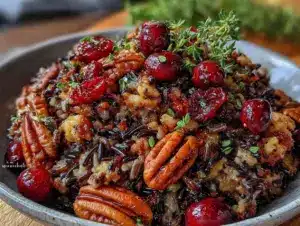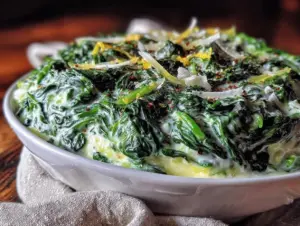Golden, bubbling, and impossibly smooth—this butternut squash mac and cheese recipe was born from a chilly autumn night, a half-forgotten squash in my pantry, and a craving for comfort food that didn’t feel heavy. The first time I made it, the aroma of roasting squash and toasted sage filled my kitchen, and honestly, I knew I’d stumbled onto something special. Imagine classic mac and cheese, but with the natural sweetness and velvety texture of butternut squash, plus crispy sage breadcrumbs that shatter with every forkful. That’s what you’re in for.
I’ve tweaked and tested this recipe more times than I can count. I’ve made it for family potlucks, cozy weeknight dinners, and even picky eaters who swore they “hated vegetables.” Guess what? They cleaned their plates. The butternut squash blends right into the cheese sauce, making it lusciously smooth and subtly sweet. If you’re after a dish that feels special, packs in some veggies, and still oozes with cheesy goodness, this is it. I use fresh sage from my garden (when I remember to water it) and a mix of cheeses for extra flavor depth. It’s also a little lighter than traditional mac, thanks to the squash, but nobody ever notices—they’re too busy enjoying that crispy breadcrumb topping.
This butternut squash mac and cheese is perfect for busy families, anyone looking to sneak in more veggies, or folks who want their comfort food with a twist. Whether you’re a cheese devotee or just trying to eat a little better, you’re going to love how silky and satisfying this dish is. Let’s face it: sometimes you just need a bowl of warm, creamy pasta. And with this recipe, you get all the indulgence and a little extra goodness, too.
Why You’ll Love This Butternut Squash Mac and Cheese
- Quick & Easy: This comes together in under an hour, making it totally doable for busy weeknights or when the craving hits.
- Simple Ingredients: You won’t need a specialty grocery run—everything’s pretty standard, and the butternut squash can even be pre-cut to save time.
- Perfect for Any Occasion: Whether it’s a chilly fall dinner, a holiday side, or a comforting lunch, this recipe fits the bill.
- Crowd-Pleaser: Even my vegetable-averse nephew devours this; the kids and adults always go for seconds.
- Unbelievably Delicious: The texture is super creamy, but not heavy, and the crispy sage breadcrumbs? They’re honestly addictive.
What sets this butternut squash mac and cheese apart is how the squash is roasted and blended right into the sauce. It makes everything extra silky, adds a subtle sweetness, and stretches the cheese flavor without feeling like you’re eating pure veggies. The sage breadcrumbs are my secret weapon—just a quick toss of fresh sage and panko in olive oil, toasted until crunchy. That little herbal kick and crunch on top make every bite interesting.
This isn’t just good—it’s the kind of cozy food that makes you pause after the first bite. For me, it’s become my go-to when I want something comforting but not too heavy. If you love mac and cheese but want something just a bit more nourishing (and, let’s be honest, Instagram-worthy), you’ll adore this. Plus, you can serve it family-style for gatherings, or portion it out for easy lunches. It’s a recipe that always delivers, no matter what.
What Ingredients You Will Need
This recipe uses simple, wholesome ingredients to deliver bold flavor and satisfying texture without the fuss. Most of what you need is probably already in your pantry or fridge, and there’s plenty of room for easy swaps if you’re missing something.
- For the Mac and Cheese:
- Butternut squash, peeled and cubed (about 2 cups / 300g)—the star for silky texture and subtle sweetness
- Elbow macaroni (8 oz / 225g)—or use shells, cavatappi, or gluten-free pasta
- Sharp cheddar cheese, grated (1 1/2 cups / 170g)—adds classic cheesy flavor
- Gruyère or fontina cheese, grated (1/2 cup / 50g)—for depth and meltiness (can sub all cheddar)
- Whole milk (1 1/4 cups / 300ml)—makes the sauce rich and smooth
- Unsalted butter (3 tbsp / 42g)—for sautéing and richness
- All-purpose flour (2 tbsp / 16g)—thickens the sauce (use gluten-free if needed)
- Garlic, minced (2 cloves)—a little savory backbone
- Nutmeg, freshly grated (1/4 tsp)—adds warmth (optional)
- Salt and black pepper—to taste
- For the Crispy Sage Breadcrumbs:
- Fresh sage leaves (8-10)—for earthy, herbal flavor
- Panko breadcrumbs (3/4 cup / 45g)—for all the crunch
- Olive oil (2 tbsp / 30ml)—helps everything crisp up
- Pinch of salt
If you need to make swaps, here’s what works: For dairy-free, use plant-based milk and cheese; for gluten-free, opt for gluten-free pasta and flour. I love using Cabot sharp cheddar for its bold flavor, but honestly, any well-melting cheese works. You can use pre-cut squash to save time, and if fresh sage isn’t available, dried sage works in a pinch (though fresh is best for color and aroma).
For more protein, toss in a handful of cooked chicken or crumbled bacon. If you’re low on breadcrumbs, try crushed crackers or even crispy onions. This recipe’s super forgiving—just keep that butternut squash front and center!
Equipment Needed
- Large pot—for boiling pasta (I use my old stainless steel stockpot; it’s seen hundreds of batches)
- Baking sheet—for roasting butternut squash (parchment makes cleanup easy)
- Medium saucepan—for cheese sauce prep
- Blender or food processor—to puree the squash into the sauce (immersion blender works too)
- Skillet—for toasting breadcrumbs
- Mixing bowls—for tossing everything together
- Measuring cups and spoons—precise sauce means perfect texture
- Whisk—for lump-free cheese sauce
- Casserole dish (2-quart)—for baking, if you like a crispy top
If you don’t have a blender, mash the roasted squash by hand—it won’t be as silky, but still tasty. I’ve used everything from a simple Pyrex dish to a fancy cast iron skillet for baking; both work. For breadcrumbs, a nonstick skillet is easiest, but any frying pan will do. Keep your tools clean—sticky cheese sauce is no fun to scrub, so soak pans right after use!
Honestly, you don’t need anything fancy. Even budget pots and pans work for this recipe. If you’re new to roasting, parchment paper helps prevent sticking and speeds up cleanup (and I’m all for fewer dishes).
Preparation Method
- Roast the butternut squash (20-25 min):
Preheat your oven to 400°F (200°C). Toss 2 cups (300g) peeled, cubed butternut squash with 1 tbsp olive oil and a pinch of salt. Spread on a lined baking sheet. Roast for 20-25 minutes until fork-tender and lightly caramelized. (Tip: Smaller cubes roast faster and give more flavor.) - Cook the pasta (8-10 min):
While the squash roasts, boil 8 oz (225g) elbow macaroni in salted water according to package instructions. Drain and set aside. (Save 1/2 cup of pasta water for thinning sauce if needed.) - Make the crispy sage breadcrumbs (5-6 min):
Heat 2 tbsp olive oil in a skillet over medium heat. Add 8-10 fresh sage leaves; fry for 30 seconds until crisp. Remove sage and crumble. Add 3/4 cup (45g) panko to the oil, toss until golden and crunchy, 3-4 minutes. Stir in crumbled sage and a pinch of salt. Set aside. - Prepare the cheese sauce (10 min):
Melt 3 tbsp (42g) butter in a medium saucepan over medium heat. Add 2 tbsp (16g) flour, whisking for 1 minute (watch for bubbling but no browning). Add 2 cloves minced garlic; cook 30 seconds until fragrant. Gradually whisk in 1 1/4 cups (300ml) milk. Simmer for 2-3 minutes until thickened slightly. - Blend squash into sauce (2 min):
Add the roasted squash to the saucepan. Use a blender or immersion blender to blend until silky smooth. (If sauce seems too thick, add a splash of reserved pasta water.) - Finish the sauce (2 min):
Stir in 1 1/2 cups (170g) cheddar and 1/2 cup (50g) Gruyère cheese until melted and smooth. Season with 1/4 tsp nutmeg, salt, and pepper to taste. (Sauce should be creamy and coat the back of a spoon.) - Combine and bake (optional, 15 min):
Toss cooked pasta with cheese sauce. Pour into a 2-quart casserole dish. Sprinkle crispy sage breadcrumbs over the top. Bake at 375°F (190°C) for 12-15 minutes if you want a bubbly, golden crust. (Or serve straight from the pot for a stovetop version.) - Sensory cues:
The sauce should smell cheesy with a hint of sweet squash. Breadcrumbs should be deeply golden and crunchy. Pasta should be al dente, not mushy. If everything looks silky and smells amazing, you’re good!
Troubleshooting: If the sauce is too thick, add a splash of milk or pasta water. If too thin, simmer a little longer or add an extra pinch of cheese. Breadcrumbs burning? Lower the heat and keep stirring. For extra flavor, let the casserole rest 5 minutes before serving—flavors meld!
Efficiency tip: Roast squash and boil pasta at the same time. Toast breadcrumbs while sauce simmers. You’ll have dinner ready in no time (and less kitchen chaos)!
Cooking Tips & Techniques
Honestly, I’ve messed up mac and cheese more times than I care to admit, but these tricks keep things reliably delicious:
- For ultra-silky sauce, blend the squash while still warm—cold squash makes the sauce grainy.
- Don’t let the cheese boil; it’ll separate and turn greasy. Remove pan from heat before stirring in cheese.
- If your breadcrumbs start to burn, take the pan off the heat and stir frequently. Lower temps are your friend!
- Use freshly grated cheese for best melting—pre-shredded cheese has anti-caking agents that can make the sauce gritty.
- Try multitasking by roasting squash and boiling pasta at the same time. Saves so much time.
- For consistent results, measure your milk and flour precisely. Guesswork leads to runny sauce or gluey mess.
- If you want more flavor, add a dash of mustard powder or smoked paprika to the sauce. I do this sometimes for a grown-up twist.
- Never skip seasoning at the end—taste and adjust salt and pepper before serving.
One time I forgot to toast the breadcrumbs and just tossed raw panko on top. Let’s just say it was…meh. The little bit of olive oil and toasting makes all the difference. Another lesson: don’t rush the blending—smooth sauce is worth the extra minute. If you need to reheat, do it gently on the stove with a splash of milk to revive the creaminess.
Variations & Adaptations
- Gluten-Free: Use gluten-free pasta and flour, plus gluten-free panko. I’ve done this for friends and the result is just as creamy and comforting.
- Dairy-Free: Sub in oat or almond milk, vegan butter, and plant-based cheeses. The squash keeps it silky even without dairy.
- Seasonal Twist: Swap butternut squash for roasted pumpkin or sweet potato in the fall, or try carrots for a spring version.
- Protein Boost: Stir in shredded rotisserie chicken or crumbled bacon before baking for a heartier meal.
- Herb Swap: Use thyme or rosemary instead of sage if that’s what you have on hand.
- Extra Veggies: Fold in sautéed spinach, peas, or broccoli with the pasta for even more color and nutrition.
I once added leftover roasted garlic to the cheese sauce—wow, the flavor was amazing. This recipe welcomes experimentation, so don’t be afraid to try your own combos. For allergens, you can swap out dairy and gluten ingredients easily. Just keep the process the same, and you’ll end up with something delicious no matter what.
Serving & Storage Suggestions
For best results, serve your butternut squash mac and cheese piping hot, right out of the oven (or off the stove). The breadcrumbs stay crisp and the sauce extra luscious. I love to garnish with an extra sprinkle of sage or a dusting of black pepper.
- Serving Ideas: Pair with a simple green salad, roasted chicken, or crusty bread. It’s also great alongside grilled veggies or as part of a holiday spread.
- Beverages: Try with crisp white wine, sparkling cider, or even a cold lemonade—something that cuts through the richness.
For leftovers, let the mac and cheese cool completely, then transfer to an airtight container. Refrigerate for up to 3 days. It reheats best on the stovetop with a splash of milk—microwaving works, but stir halfway to prevent drying out. If you want to freeze, portion into single servings and wrap tightly; thaw in the fridge overnight before reheating.
Tip: The flavors deepen after a day in the fridge, so leftovers taste even better. Just add a fresh sprinkle of breadcrumbs when serving again—trust me, it’s worth it.
Nutritional Information & Benefits
Each serving (about 1 cup) of this butternut squash mac and cheese has roughly:
- Calories: 350
- Protein: 13g
- Fat: 12g
- Carbohydrates: 44g
- Fiber: 4g
Butternut squash is loaded with vitamin A, C, and potassium, adding a healthy boost to classic comfort food. The recipe is lighter than traditional mac thanks to the veggie base, and you can adjust the cheeses or pasta to fit gluten-free, vegetarian, or high-protein diets. Watch for dairy and gluten if you have allergies—easy swaps are listed above. Personally, I love how this recipe fits into my “eat more veggies, enjoy my food” philosophy. It’s comfort you can feel good about.
Conclusion
If you’re craving classic comfort food with a fresh twist, this butternut squash mac and cheese is absolutely worth making. It’s silky, cheesy, a little sweet, and the crispy sage breadcrumbs take it over the top. There’s plenty of room to customize—make it gluten-free, add more veggies, or swap cheeses to suit your taste.
I find myself coming back to this recipe over and over, especially when I want something cozy and nourishing. It’s become a family favorite and always gets rave reviews. If you try it, I’d love to hear your thoughts—drop a comment, share your adaptations, or tag me with your cheesy masterpieces!
Warm wishes from my kitchen to yours—here’s to comfort food with a twist and many happy, melty meals ahead!
Frequently Asked Questions
Can I use frozen butternut squash for this mac and cheese?
Yes! Just thaw and drain well before roasting; it may cook a little faster, so check for tenderness early.
Can I make this recipe ahead of time?
Absolutely. Prepare up to baking, cover, and refrigerate. Bake when ready to serve, adding breadcrumbs just before.
What’s the best cheese substitute for Gruyère?
Fontina, Emmental, or even Monterey Jack work well. Use extra cheddar if you prefer the classic flavor.
How do I reheat leftovers without drying them out?
Reheat gently on the stove with a splash of milk, or microwave in short bursts, stirring halfway through.
Can I use gluten-free pasta and breadcrumbs?
Yes! Substitute with your favorite gluten-free brands for both pasta and breadcrumbs—the result is just as creamy and crunchy.

Butternut Squash Mac and Cheese: Easy Silky Recipe with Crispy Sage Breadcrumbs
- Total Time: 45 minutes
- Yield: 4 servings 1x
Description
This butternut squash mac and cheese blends roasted squash into a creamy cheese sauce for a lighter, veggie-packed twist on classic comfort food. Crispy sage breadcrumbs add a crunchy, herbal finish that makes every bite irresistible.
Ingredients
- 2 cups butternut squash, peeled and cubed (about 1 medium squash)
- 8 oz elbow macaroni (about 2 cups dry)
- 1 1/2 cups sharp cheddar cheese, grated
- 1/2 cup Gruyère or fontina cheese, grated
- 1 1/4 cups whole milk
- 3 tbsp unsalted butter
- 2 tbsp all-purpose flour
- 2 cloves garlic, minced
- 1/4 tsp freshly grated nutmeg (optional)
- Salt and black pepper, to taste
- 8–10 fresh sage leaves
- 3/4 cup panko breadcrumbs
- 2 tbsp olive oil
- Pinch of salt (for breadcrumbs)
- 1 tbsp olive oil (for roasting squash)
Instructions
- Preheat oven to 400°F (200°C). Toss butternut squash cubes with 1 tbsp olive oil and a pinch of salt. Spread on a lined baking sheet and roast for 20-25 minutes until fork-tender and lightly caramelized.
- While squash roasts, boil elbow macaroni in salted water according to package instructions (8-10 minutes). Drain and set aside, reserving 1/2 cup pasta water.
- Heat 2 tbsp olive oil in a skillet over medium heat. Add sage leaves and fry for 30 seconds until crisp. Remove and crumble. Add panko breadcrumbs to the oil, toss until golden and crunchy (3-4 minutes). Stir in crumbled sage and a pinch of salt. Set aside.
- Melt butter in a medium saucepan over medium heat. Add flour, whisking for 1 minute until bubbling but not browned. Add minced garlic and cook for 30 seconds until fragrant.
- Gradually whisk in milk. Simmer for 2-3 minutes until slightly thickened.
- Add roasted squash to the saucepan. Blend with a blender or immersion blender until silky smooth. If sauce is too thick, add reserved pasta water.
- Stir in cheddar and Gruyère cheese until melted and smooth. Season with nutmeg, salt, and pepper to taste.
- Toss cooked pasta with cheese sauce. Pour into a 2-quart casserole dish. Sprinkle crispy sage breadcrumbs over the top.
- Bake at 375°F (190°C) for 12-15 minutes for a bubbly, golden crust, or serve straight from the pot for a stovetop version.
- Let casserole rest for 5 minutes before serving for best flavor and texture.
Notes
For ultra-silky sauce, blend squash while warm. Use freshly grated cheese for best melting. If sauce is too thick, add a splash of milk or pasta water. For gluten-free or dairy-free, substitute pasta, flour, breadcrumbs, milk, and cheese as needed. Let casserole rest before serving for flavors to meld. Breadcrumbs are best toasted in olive oil for crunch.
- Prep Time: 20 minutes
- Cook Time: 25 minutes
- Category: Main Course
- Cuisine: American
Nutrition
- Serving Size: About 1 cup per serving
- Calories: 350
- Sugar: 6
- Sodium: 480
- Fat: 12
- Saturated Fat: 6
- Carbohydrates: 44
- Fiber: 4
- Protein: 13
Keywords: butternut squash, mac and cheese, comfort food, vegetarian, easy dinner, fall recipe, sage, breadcrumbs, casserole, creamy pasta




